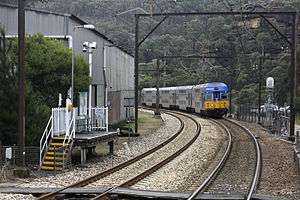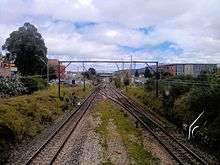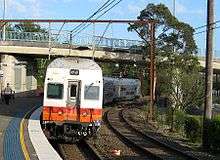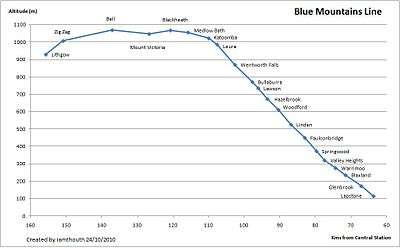Blue Mountains Line
|
| |||||||||||
 A NSW TrainLink V set approaches Zig Zag station. | |||||||||||
| Overview | |||||||||||
|---|---|---|---|---|---|---|---|---|---|---|---|
| Service type | Intercity rail | ||||||||||
| Locale | Blue Mountains and Central West, New South Wales | ||||||||||
| Current operator(s) | NSW TrainLink | ||||||||||
| Route | |||||||||||
| Start | Central | ||||||||||
| Stops | 21 | ||||||||||
| End | Bathurst | ||||||||||
| Line(s) used | Main Western | ||||||||||
| Technical | |||||||||||
| Rolling stock | NSW TrainLink V set and Endeavour railcar | ||||||||||
| Track gauge | 1,435 mm (4 ft 8 1⁄2 in) standard gauge | ||||||||||
| Track owner(s) | RailCorp | ||||||||||
| |||||||||||
The Blue Mountains Line is an intercity rail service operated by NSW TrainLink serving the Blue Mountains region of New South Wales, Australia. The line travels west from Sydney to the major town of Katoomba and on to Lithgow on the western foothills of the mountains. 2 Express services per day in each direction, known as the Bathurst Bullet, extend to the regional city of Bathurst, which is supplemented by road coaches connecting Bathurst to Lithgow. The Blue Mountains Line operates over a mostly duplicated section of the Main Western line. As such, the tracks are also traversed by the Central West XPT, Outback Xplorer and Indian Pacific passenger services and by freight trains.
History

The Blue Mountains line is a section of the Main Western line which opened in 1868.[1] The line was built with gradients as steep as 1 in 33 (3%) and curves as sharp as 8 chains (160m). Most of the curves were eased to 12 chains (240m) with duplication.[2]
The line originally ascended the eastern and descended the western sides of the Blue Mountains via a series of zig-zag track sections. The eastern zig zag was by passed by a tunnel in 1892 and the western zig zag (once a tourist railway) was bypassed in 1910 with the Ten Tunnels Deviation.
In the 1950s, the line was electrified primarily as a means of easing the haulage of coal freight from the western coalfields to the coastal ports,[3] but a by-product of this programme was the introduction of electric interurban passenger services as far west as Bowenfels, later cut back to the current terminus of Lithgow.[4] Goods trains are now exclusively diesel hauled. Electric passenger services were originally provided by a combination of electric locomotive hauled carriages and single deck electric multiple unit sets (known as U sets), both of which have now been withdrawn and replaced by more modern rolling stock.
In June 2012, New South Wales Premier Barry O'Farrell announced that services would be extended to Bathurst. The service, commonly known as the Bathurst Bullet, commenced on 21 October 2012.[5][6]
Services

The line is operated by NSW TrainLink V sets. As the electric overhead wiring ends at Lithgow, diesel-electric Endeavour railcars operate the services to and from Bathurst.
All Blue Mountains line services start and terminate from the intercity platforms (4-15) of Central (Sydney Terminal) station.
Some off-peak electric interurban services on the line only consist of four carriages, with peak hour services usually consisting of eight carriages. Regional diesel services on the line consist of 2 carriages.
Blue Mountains line stations

- Central
- Redfern
- Strathfield
- Parramatta
- Westmead
- Blacktown
- Penrith
- Emu Plains
- Lapstone
- Glenbrook
- Blaxland
- Warrimoo
- Valley Heights
- Springwood - intermediate terminus, primarily during peak hours
- Faulconbridge
- Linden
- Woodford
- Hazelbrook
- Lawson
- Bullaburra
- Wentworth Falls
- Leura
- Katoomba - major intermediate terminus
- Medlow Bath
- Blackheath
- Mount Victoria - intermediate terminus
- Hartley Vale- closed
- Bell
- Newnes Junction- closed
- Clarence- closed
- Zig Zag - for Zig Zag Railway museum
- Lithgow - terminus for electric services
- Bathurst - terminus, 2 services in each direction per day
Coach services stop at the following locations:
Patronage
The following table shows the patronage of each line of the NSW TrainLink Intercity network for the year ending 30 June 2018, based on Opal tap on and tap off data.[7]
| 10 168 000 |
 | |
| 19 441 000 | ||
| 926 000 | ||
| 9 851 000 | ||
| 1 059 000 |
References
- ↑ "Main West Line". Nswrail.net.
- ↑ Steam Working over the Blue Mountains Groves, K.T. Australian Railway Historical Society Bulletin, December 1971 pp265-280; January 1974 pp1-19
- ↑ Blue Mountains Electrification - 50 Years Later, Miller, Stephen Australian Railway History, January 2008 pp1-21
- ↑ "Single Deck InterUrban cars". SETS.
- ↑ "O'Farrell announces daily rail service to Sydney". Western Advocate. 4 June 2012.
- ↑ "Blue Mountains line timetable". Transport for NSW.
- ↑ "Train Patronage - Monthly Figures". Transport for NSW. Retrieved 14 September 2018.